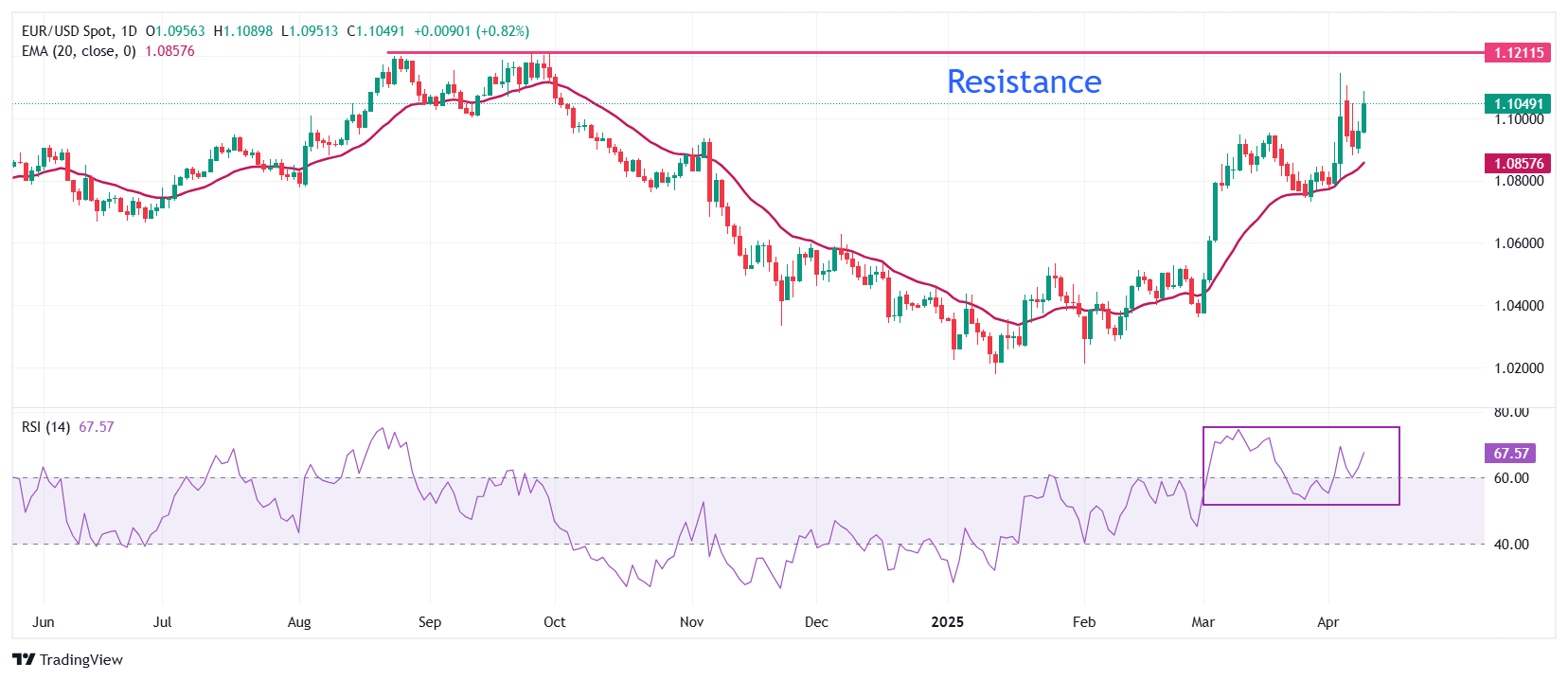
EUR/USD jumps above 1.1050 as the US Dollar faces pressures on the brewing trade war between the US and China.
China warns of countermeasures against Trump’s hefty reciprocal tariffs.
ECB Šimkus supports an interest rate cut in April.
EUR/USD advances to near 1.1050 in Wednesday’s European session. The major currency pair remains firm as the US Dollar (USD) stays under pressure on the brewing trade war between the United States (US) and China.
Through the so-called White Paper, Beijing said that China will take countermeasures to “safeguard its rights and interests”. The nation believes in the essence of “US-China trade ties” but firmly opposes “unilateral and bullying restrictive measures”. China has cleared through the White Paper that it will “resolutely counteract and fight to the end”.
These comments from Beijing have come in the face of an increase in reciprocal tariffs by US President Donald Trump on China. On Tuesday, Trump raised import duty to 104% on China following Beijing’s countermeasure of 34% levy on imports from the US.
Market participants worry that the escalating trade war between the world’s biggest powerhouses could push the US economy into a recession. This has led to a sharp increase in traders’ bets supporting the Federal Reserve (Fed) to resume the monetary policy easing cycle, which it paused in January. According to the CME FedWatch tool, the probability for the central bank to cut interest rates in May has increased to 52.5% from 10.6% recorded a week ago. The tool also shows that traders are confident that the central bank will cut interest rates in the June meeting.
Meanwhile, investors await the Federal Open Market Committee (FOMC) minutes of the March policy meeting for fresh cues on the monetary policy outlook. In March, Fed officials guided that interest rates should remain in their current range of 4.25%-4.50% until they get clarity on how the President's policies will shape the monetary policy and the economic outlook.
On the economic front, investors will focus on the US Consumer Price Index (CPI) data for March, which will be released on Thursday. The inflation report is expected to show that the headline and core CPI rose moderately by 2.6% and 3%, respectively.
Daily digest market movers: EUR/USD gains after German leaders agree on a coalition
The strength in the EUR/USD pair is also driven by the Euro’s (EUR) outperformance. The major currency gains after German political parties agreed to form a coalition. The Christian Democratic Union (CDU), led by Frederich Merz, reached a deal with centre-left Social Democrats (SPD) to form a government, Reuters report. A positive development in stabilization in Germany’s government would advance debt-restructuring plans and the creation of the infrastructure fund.
However, investors brace for volatility in the Euro in the face of Trump-led tariffs. Market participants expect that Trump's imposition of 20% reciprocal tariffs on the Eurozone will dampen the already vulnerable Eurozone economic growth, especially in Germany, the largest exporting nation of the bloc to the US.
In response to Trump’s higher import duties, finance ministers of all Euro area countries are scheduled to meet in Warsaw on Friday to discuss measures to contain the likely consequences of tariffs imposed by the US. Ahead of the meeting, Poland Finance Minister Andrzej Domański said, "Disrupted supply chains and rising costs for companies will affect European growth ratios and currencies."
Additionally, the deepening expectation of more interest rate cuts from the European Central Bank (ECB) is also expected to exert some pressure on the Euro. On Tuesday, ECB Governing Council member Gediminas Šimkus said that a “25 basis points (bps) rate cut is needed in April.” Šimkus added that the US tariff announcement warrants a “more accommodative” monetary policy, therefore, we need to move to a “less restrictive policy stance”.
Technical Analysis: EUR/USD climbs above 1.1050

EUR/USD jumps above 1.1050 on Wednesday and aims to revisit the six-month high of 1.1147. The near-term trend of the major currency pair is bullish as it holds above the 20-day Exponential Moving Average (EMA), which trades around 1.0856.
The 14-day Relative Strength Index (RSI) rebounds higher after cooling down to near 60.00, suggesting that a bullish momentum has resumed.
Looking down, the March 31 high of 1.0850 will act as the major support zone for the pair. Conversely, the September 25 high of 1.1214 will be the key barrier for the Euro bulls.
* The content presented above, whether from a third party or not, is considered as general advice only. This article should not be construed as containing investment advice, investment recommendations, an offer of or solicitation for any transactions in financial instruments.

